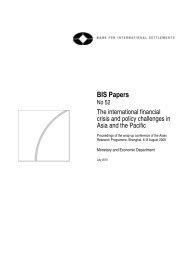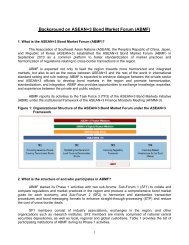asia bond monitor - AsianBondsOnline - Asian Development Bank
asia bond monitor - AsianBondsOnline - Asian Development Bank
asia bond monitor - AsianBondsOnline - Asian Development Bank
Create successful ePaper yourself
Turn your PDF publications into a flip-book with our unique Google optimized e-Paper software.
Highlights<br />
Asia Bond Monitor<br />
• Financial markets have been gripped by<br />
potentially destabilizing factors, ranging from<br />
rapidly rising food and commodity prices to<br />
political uncertainty in the Middle East. At the<br />
same time, however, most emerging East <strong>Asian</strong><br />
economies have continued to grow rapidly.<br />
• The combination of these factors has led to a<br />
steady stream of policy rate hikes in recent<br />
months throughout emerging East Asia.<br />
• Recent developments have had a two-fold effect<br />
on the region’s government <strong>bond</strong> yield curves:<br />
both flattening and shifting yield curves upward<br />
in most markets. This flattening trend has<br />
occurred in spite of continued capital inflows.<br />
• Total local currency (LCY) <strong>bond</strong>s outstanding<br />
grew by 13.6% year-on-year (y-o-y) to<br />
USD5.2 trillion in 4Q10, driven more by<br />
corporate <strong>bond</strong>s (20.3%) than by government<br />
<strong>bond</strong>s (10.8%).<br />
• The overall y-o-y growth rate of the market<br />
in 4Q10 presents a pattern of more balanced<br />
growth. The emerging East <strong>Asian</strong> <strong>bond</strong> market<br />
excluding the People’s Republic of China (ex-<br />
PRC) grew 11.6% y-o-y in 4Q10.<br />
• The PRC’s overall <strong>bond</strong> market grew 15.1% y-o-y<br />
in 4Q10. However, the <strong>bond</strong> markets of Viet Nam,<br />
Malaysia, and Singapore grew even more<br />
rapidly at y-o-y rates of 34.2%, 18.9%, and<br />
15.9%. Additionally, Thailand’s growth rate was<br />
an impressive 14.4%.<br />
• The growth of the PRC’s government <strong>bond</strong><br />
market declined to 10.3% y-o-y in 4Q10 from<br />
15.6% in the previous quarter, while large<br />
increases in issuance from the central banks of<br />
Malaysia and Thailand limited the decline of the<br />
growth rate of the region’s government <strong>bond</strong><br />
market ex-PRC to 11.8% y-o-y in 4Q10 from<br />
12.5% in 3Q10.<br />
• The PRC’s corporate <strong>bond</strong> market grew an<br />
impressive 37.2% y-o-y in 4Q10, however,<br />
this was exceeded by growth of 41.4% y-o-y<br />
in Viet Nam. The corporate <strong>bond</strong> markets of<br />
Singapore (30.9%), Indonesia (29.8%), and<br />
the Republic of Korea (11.1%) also exhibited<br />
solid growth in 4Q10.<br />
• Almost all emerging East <strong>Asian</strong> corporate <strong>bond</strong><br />
markets share a similar, interesting structure:<br />
the top 6–8 companies in each market issue<br />
<strong>bond</strong>s in very large amounts, with the remaining<br />
top 30–50 issuers in each market offering much<br />
smaller amounts. This results in an asymptotic<br />
curve for the distribution of <strong>bond</strong>s outstanding.<br />
This trend is most pronounced in the corporate<br />
<strong>bond</strong> markets of the PRC and Thailand.<br />
• LCY <strong>bond</strong> issuance for 2010 as a whole totaled<br />
USD3.8 trillion in emerging East Asia, a 10.2%<br />
increase over 2009. Issuance in 4Q10 declined<br />
by 20.4% y-o-y and 27.6% q-o-q, but this was<br />
offset by substantial issuance earlier in 2010.<br />
• Foreign participation in the region’s LCY <strong>bond</strong><br />
market continued to expand in 4Q10, as foreign<br />
investors hunted for yield and anticipated<br />
appreciation of the underlying currencies.<br />
• G3 currency <strong>bond</strong> issuance from emerging East<br />
Asia in 2010 hit USD87.2 billion in 2010, a<br />
38% increase over issuance of USD63.2 billion<br />
in 2009. G3 currency issuance remained<br />
robust in the early months of 2011, reaching<br />
USD12.3 billion by mid-March.<br />
• The major risks to the region’s outlook at<br />
present are rapidly rising prices for food, oil,<br />
and commodities, and the possibility that<br />
central banks will continue to raise their policy<br />
rates in 2011. The “risk on–risk off” behavior<br />
of the market could add to these risks and the<br />
volatility of the outlook.<br />
2







